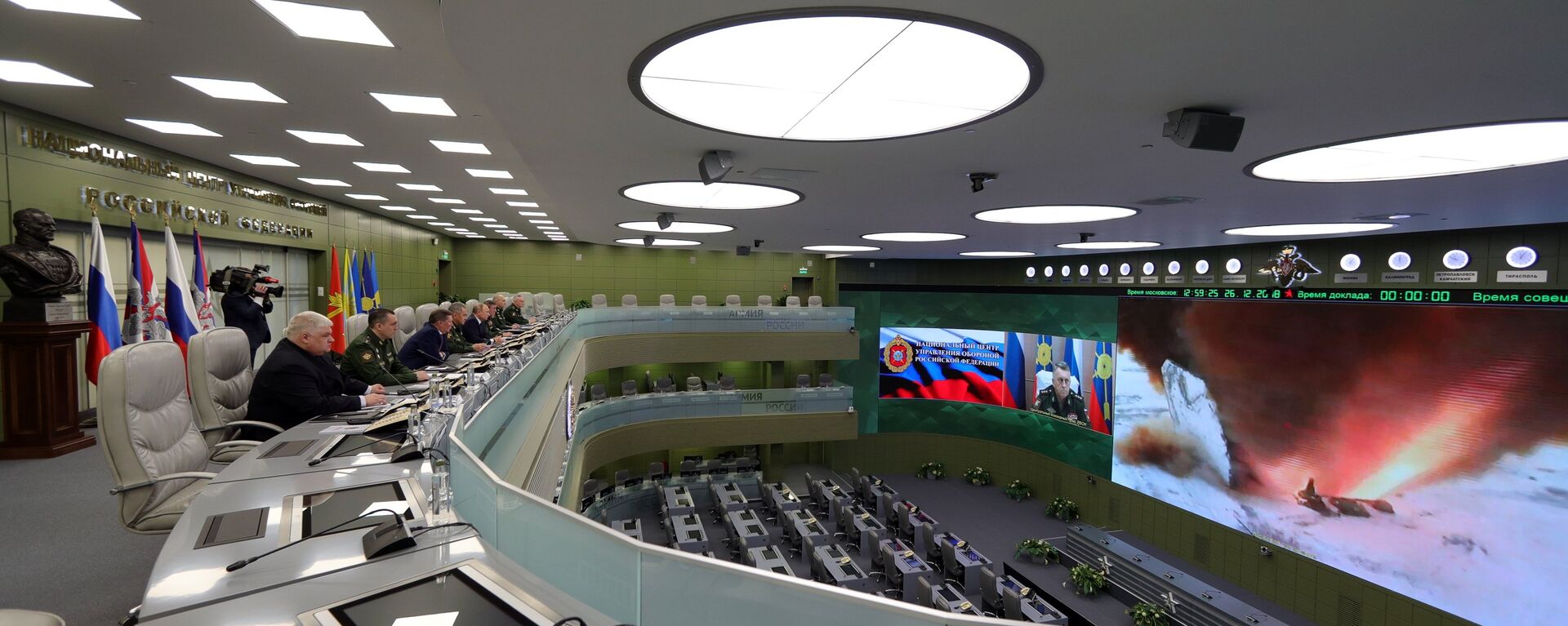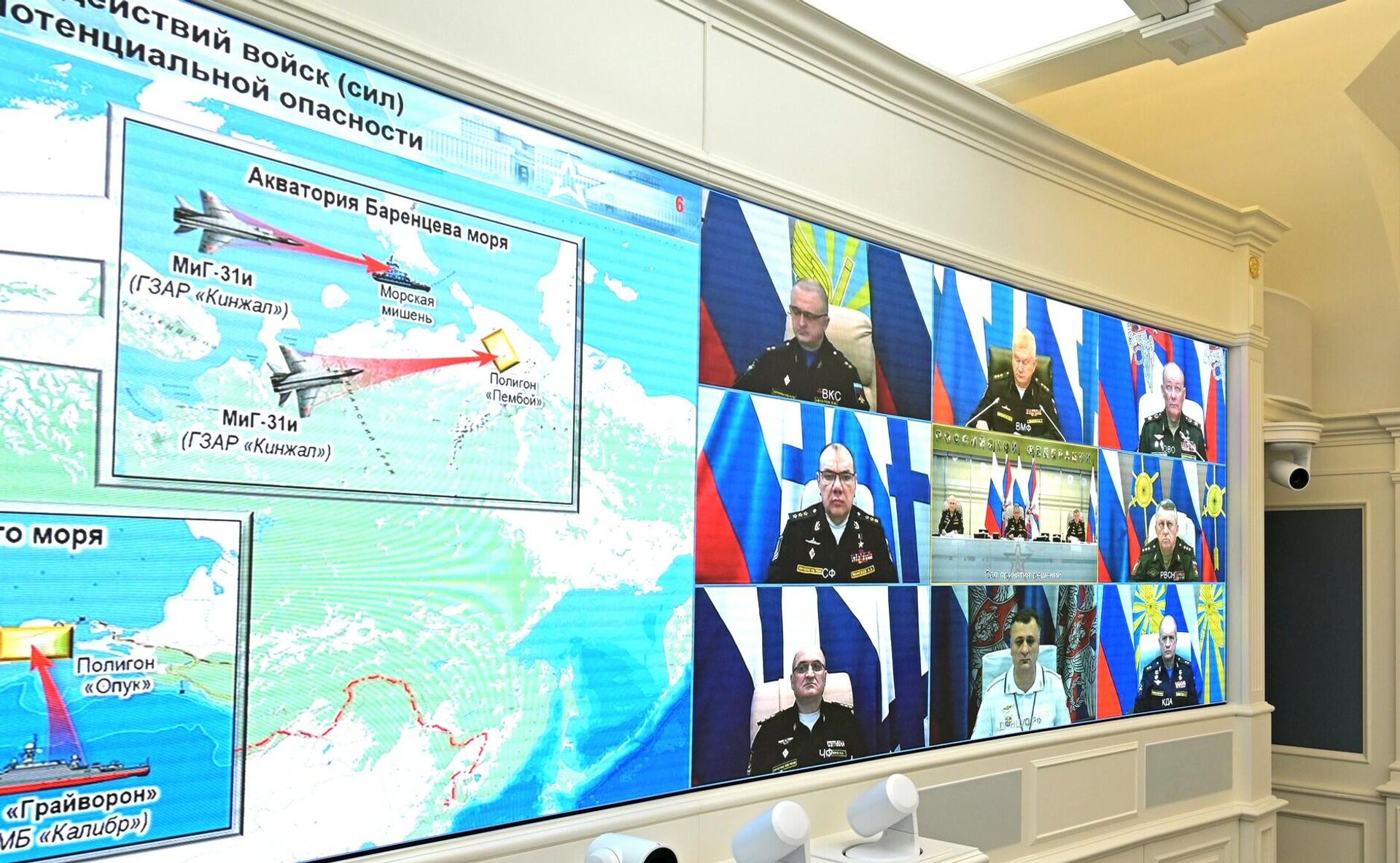https://sputnikglobe.com/20220219/russian-aerospace-force-successfully-launches-kinzhal-hypersonic-missiles-during-drills-1093174539.html
Russian Military Fires Kinzhal Hypersonic Missiles, Yars ICBM, Kalibr & Zircon in Drills - Videos
Russian Military Fires Kinzhal Hypersonic Missiles, Yars ICBM, Kalibr & Zircon in Drills - Videos
Sputnik International
The Kh-47M2 Kinzhal aircraft-deployed hypersonic cruise missile system is nuclear capable, and is one of several hypersonic weapons rolled out by Russia in the... 19.02.2022, Sputnik International
2022-02-19T11:16+0000
2022-02-19T11:16+0000
2022-02-19T13:01+0000
kinzhal missile system
https://cdn1.img.sputnikglobe.com/img/07e6/02/13/1093175363_364:139:1673:876_1920x0_80_0_0_337ac2b59f99425ca2368db53941be48.png
The Kremlin has revealed details about Saturday's missile drills, indicating that the exercises included the successful launch of Kinzhal cruise missiles by MiG-31 aircraft, and Kalibr and Zircon missiles fired by warships and submarines of the Northern and Black Sea Fleets against naval and ground targets.In addition, a Yars intercontinental ballistic missile was launched from the Plesetsk cosmodrome toward the Kura range in Kamchatka, over 5,800 km away.Tu-95MS stratbombers fired cruise missile targets at the Kura and Pemboy ranges.A test of a short-range Iskander ballistic missile was also conducted at the Kapustin Yar testing range in Astrakhan region.Russian President and Commander in Chief Vladimir Putin gave the go-ahead to the drills, speaking to Chief of General Staff Valery Gerasimov and other commanders from a command center in the Kremlin alongside Belarusian President Alexander Lukashenko.The drills involved the Russian Aerospace Force, units of the Southern Military District, the Strategic Missile Troops, the Northern and Black Sea Fleets.According to the Kremlin, the exercises were planned in advance, and they enabled checks of military command and control organs, launch crews, the crews of warships and strategic bombers, as well as the reliability of the weapons of strategic nuclear and non-nuclear forces."The tasks envisaged during the exercise of the strategic deterrence forces were completed in full, all missiles hit their assigned targets, confirming the specified characteristics," the Kremlin said in its statement.Russia began modernising its strategic nuclear forces and working to develop hypersonic systems capable of evading missile defences in the early 2000s, after the US unilaterally moved to scrap the Anti-Ballistic Missile Treaty of 1972 - which placed severe limits on the development and deployment of anti-ballistic missile systems. The Russian military considers its hypersonic systems as a security guarantee against enemy aggression, hoping that the prospect of a retaliatory strike against any power that threatens Russia's destruction will serve to improve global strategic stability.In addition to the ABM Treaty, the US has systematically withdrawn from several other major security agreements with Russia over the years, including the 1987 Intermediate-Range Nuclear Forces Treaty, which banned the development and deployment of ground-based missile systems in the 500-5,500 km range, and the 1992 Treaty on Open Skies. The Trump administration also threatened to let the clock run out on the New Strategic Arms Reduction Treaty (New START), but that agreement was renewed by the Biden administration at the last minute.
https://sputnikglobe.com/20211013/putin-says-global-arms-race-has-accelerated-thanks-to-us-withdrawal-from-abm-treaty-1089892648.html
Sputnik International
feedback@sputniknews.com
+74956456601
MIA „Rosiya Segodnya“
2022
News
en_EN
Sputnik International
feedback@sputniknews.com
+74956456601
MIA „Rosiya Segodnya“
Sputnik International
feedback@sputniknews.com
+74956456601
MIA „Rosiya Segodnya“
kinzhal missile system
Russian Military Fires Kinzhal Hypersonic Missiles, Yars ICBM, Kalibr & Zircon in Drills - Videos
11:16 GMT 19.02.2022 (Updated: 13:01 GMT 19.02.2022) The Kh-47M2 Kinzhal aircraft-deployed hypersonic cruise missile system is nuclear capable, and is one of several hypersonic weapons rolled out by Russia in the late 2010s in a bid to preserve global strategic stability amid US efforts to build a missile defence shield.
The Kremlin has
revealed details about Saturday's missile drills, indicating that the exercises included the successful launch of Kinzhal cruise missiles by MiG-31 aircraft, and Kalibr and Zircon missiles fired by warships and submarines of the Northern and Black Sea Fleets against naval and ground targets.
The Kinzhal-armed MiG-31s were said to have fired on two separate targets - a sea-based target simulating a warship south of the Novaya Zemlya archipelago, and a ground target at the Pemboy range outside Vorkuta in the Komi Republic, northern Russia.
In addition, a Yars intercontinental ballistic missile was launched from the Plesetsk cosmodrome toward the Kura range in Kamchatka, over 5,800 km away.
Tu-95MS stratbombers fired cruise missile targets at the Kura and Pemboy ranges.
The Kura range was also struck by a R-29RMU Sineva submarine-launched ballistic missile fired by the Karelia, a nuclear-powered ballistic missile submarine operating in the Barents Sea several thousand kilometres away.
A test of a short-range Iskander ballistic missile was also conducted at the Kapustin Yar testing range in Astrakhan region.
Russian President and Commander in Chief Vladimir Putin
gave the go-ahead to the drills, speaking to Chief of General Staff Valery Gerasimov and other commanders from a command center in the Kremlin alongside Belarusian President Alexander Lukashenko.
The drills involved the Russian Aerospace Force, units of the Southern Military District, the Strategic Missile Troops, the Northern and Black Sea Fleets.
According to the Kremlin, the exercises were planned in advance, and they enabled checks of military command and control organs, launch crews, the crews of warships and strategic bombers, as well as the reliability of the weapons of strategic nuclear and non-nuclear forces.
"The tasks envisaged during the exercise of the strategic deterrence forces were completed in full, all missiles hit their assigned targets, confirming the specified characteristics," the Kremlin said in its statement.
Russia
began modernising its strategic nuclear forces and working to develop hypersonic systems capable of evading missile defences in the early 2000s, after
the US unilaterally moved to scrap the Anti-Ballistic Missile Treaty of 1972 - which placed severe limits on the development and deployment of anti-ballistic missile systems. The Russian military considers its hypersonic systems as a security guarantee against enemy aggression, hoping that the prospect of a retaliatory strike against any power that threatens Russia's destruction will serve to improve global strategic stability.

13 October 2021, 13:26 GMT
In addition to the ABM Treaty, the US has
systematically withdrawn from several other major security agreements with Russia over the years, including the 1987 Intermediate-Range Nuclear Forces Treaty, which banned the development and deployment of ground-based missile systems in the 500-5,500 km range, and the 1992 Treaty on Open Skies. The Trump administration also threatened to let the clock run out on the New Strategic Arms Reduction Treaty (New START), but that agreement was renewed by the Biden administration at the last minute.





